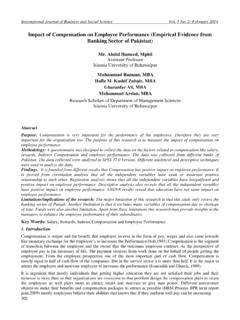Transcription of Remuneration policy - WBHO
1 Remuneration policy The principles behind the Remuneration policy designed to ensure attraction and retention of high-quality staff are as follows: competitive Remuneration packages that are realistic within the construction markets within which the group operates; reward high-performing employees for the contribution made in the region, division or company for which they work; each employee conducts themselves in line with the code of conduct (available for download as a PDF document in this section) of the group; key performance indicators (KPIs) are based on economic, social and environmental targets; manage the total cost to company for every employee (guaranteed salary); incentive packages to reward both company performance and individual/team/project performance; share-based incentives for key personnel; reference to external sources on comparative Remuneration levels within the industry; non-financial rewards and recognition to ensure key employee retention; the Remuneration policy is reviewed regularly to ensure that WBHO keeps pace with the continually changing market; attention to and consideration for all employees requirements; and ensure that all stakeholders understand the Remuneration policy .
2 Remuneration structure The integrated Remuneration structure is made up of three components: total cost to company (TCTC) incorporating basic pay, car allowance, provident fund (superannuation), medical aid, leave and various other allowances (where applicable) short-term incentive bonuses (performance-based) dependent on company and individual performances for the previous financial year and accounted for on a cash paid basis in the following financial year long-term incentives (equity based) involving share schemes and offered to senior executives and future leaders identified by the executive The company has adopted a Remuneration structure that is biased toward the performance of senior directors and key management and bonuses form a material portion of their total Remuneration .
3 Consideration is given to rewarding certain senior key staff with long-term sustainable incentives (through share-based incentives) The Remuneration structure for junior employee categories varies in accordance with levels determined by the market and the operational/functional responsibilities expected from each individual employee. Long-term, share-based incentive schemes As per the circular attached to the 2013 Integrated Report, the company proposes to implement a new executive share plan. The 2013 WBHO Share Plan will provide for the inclusion of a number of performance criteria designed to align the interests of participants (senior executives) with those of WBHO shareholders.
4 The historic, long-term, share-based incentive schemes are provided for key management and future leaders identified by the executive. These shares are allocated at a discount and ownership vests over five years. Executive directors contracts Notice periods for directors range from 30 to 180 days, dependent on strategic considerations. Certain executives who have shares in WBHO or subsidiaries have restraint of trade (non-compete) agreements for varying periods, depending on the individual circumstances. Contracts do not commit to payment for failure, Balloon payments on termination, entitlement to bonus or share based payments for termination for non-performance. South African executives have standard WBHO employment contracts, which do not have contract periods and there are also no restraints.
5 Non-executive Remuneration The Remuneration of non-executive directors is based on proposals from remco, which are submitted to the board for approval. Non-executive directors sign service contracts with the company upon appointment. The term of office of non-executive directors is governed by the memorandum of incorporation (MOI), which provides that: directors who have served for three years will retire by rotation, but may, if eligible, offer themselves for re-election for a further three-year term; and directors who have served for more than nine years will retire at the end of that term, but may, if eligible, be re-elected annually for further periods of one year at a time.
6 Fee structure The Remuneration of non-executive directors who serve on the board and its committees is reviewed by the committee annually. Remuneration is compared with that of selected peer companies on an annual basis and recommendations are then submitted to the board for approval. Non-executive Remuneration is determined and paid quarterly based on an annual fee, a non-attendance penalty is deducted for non-attendance at any meeting. Any additional time spent on company business is paid at a fixed hourly rate. Fees are approved annually on this basis at the annual general meeting and apply with effect from 01 September of that financial year. Expenses Any travel and accommodation expenses of directors are included in the fees and paid by WBHO.
7 Akani Investments participation The Akani empowerment share scheme for black partners is a 10 year share scheme with accumulative hurdle requirements, which aligns with the long-term objectives of shareholders. Three of the non-executives are partners in the Akani Investment Holdings (Pty) Limited and Broad Based Employment Trust incentive scheme, whereby in 2006 to 2010 they were allocated 633 333 Akani shares linked one-for-one to WBHO shares locked in for 10 years. The number of WBHO shares that, ul timately, vest to each partner is dependent on the market value at the end of that period dependent on a predetermined threshold. A partner is entitled to leave the scheme if a trigger event occurs and, if this were to happen at 30 June 2013, then that individual would receive 119 010 WBHO shares plus 58 196 WBHO shares purchased from dividends received during the seven (7) years that the scheme has been in existence, giving that partner 177 206 WBHO shares if the taxes due on vesting were paid directly by that partner.
8 The indirect shares held at 30 June 2013 equal 633 333 Akani linked shares plus the 58 196 WBHO shares bought from the open market, which equals 691 529 shares. Considerations ruling the Remuneration structure 1. Total cost to company (guaranteed pay) Salaried employees The TCTC that makes up our employees guaranteed Remuneration , other than the guaranteed thirteenth cheque, is monitored through stringent cost management. This procedure ensures that the cost of the Remuneration package paid to employees is properly controlled and does not include excessive liabilities. The TCTC represents a generally accepted practice for paying employees, which enables accurate and meaningful benchmarking of Remuneration packages.
9 The company attempts to position itself against the industry from which we acquire skills, or to which we are likely to lose skills. In Australia, the levels of Remuneration are compared with the national and state statistics, both for the public and private sectors. These statistics take into account TCTC and incentives, as well as allowing for seasonal requirements and special requirements. In South Africa, WBHO compares itself to the general market and the market in which it operates; furthermore, the pay levels of top executive positions in the company are benchmarked against national market executive Remuneration surveys. General adjustments to guaranteed pay levels are reviewed and adjusted.
10 These adjustments are effective 1 March (for Africa) and 1 July (for Australia) each year. The annual TCTC increase process of the group takes place during January/February, in the case of our African operations, and in May/June for our Australian operations. Annual increase parameters are determined by the committee, with guidance from executive management and reference to: market-related TCTC increases; individual promotions; individual performance; the performance of the division and company; and other relevant factors. The company follows an informal measurement framework when considering performance for increases in TCTC. Increases are dependent on divisional or department performance, personal performance and achievement.










